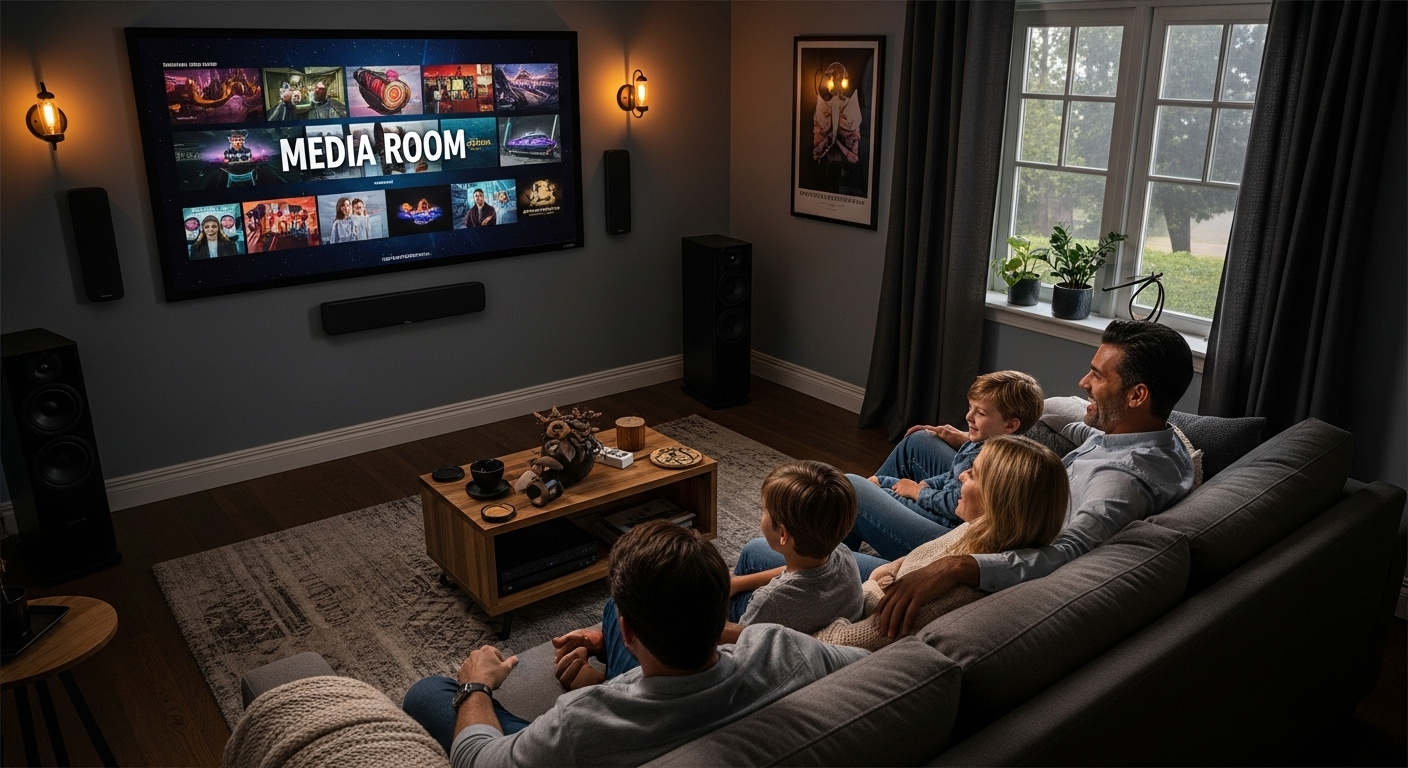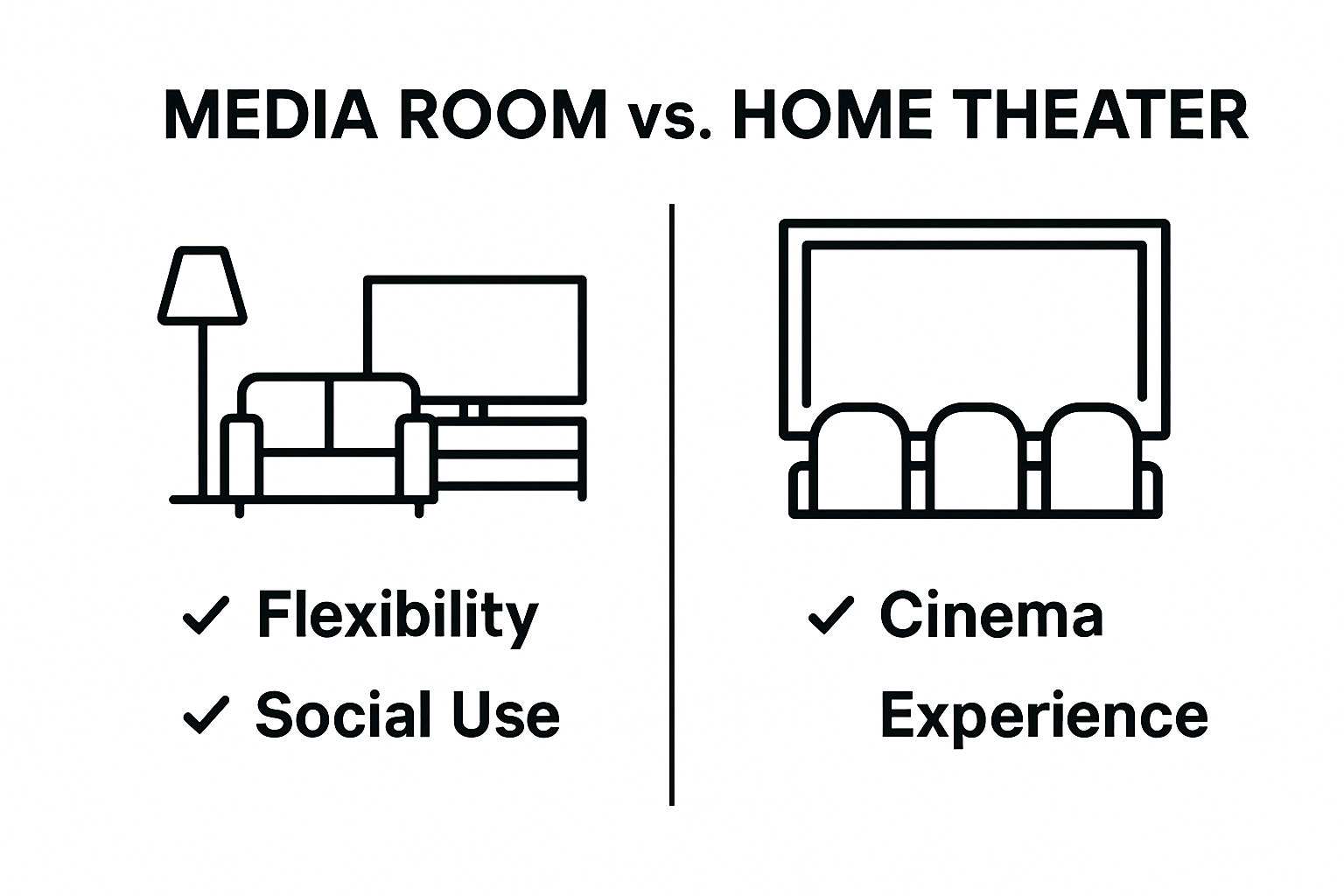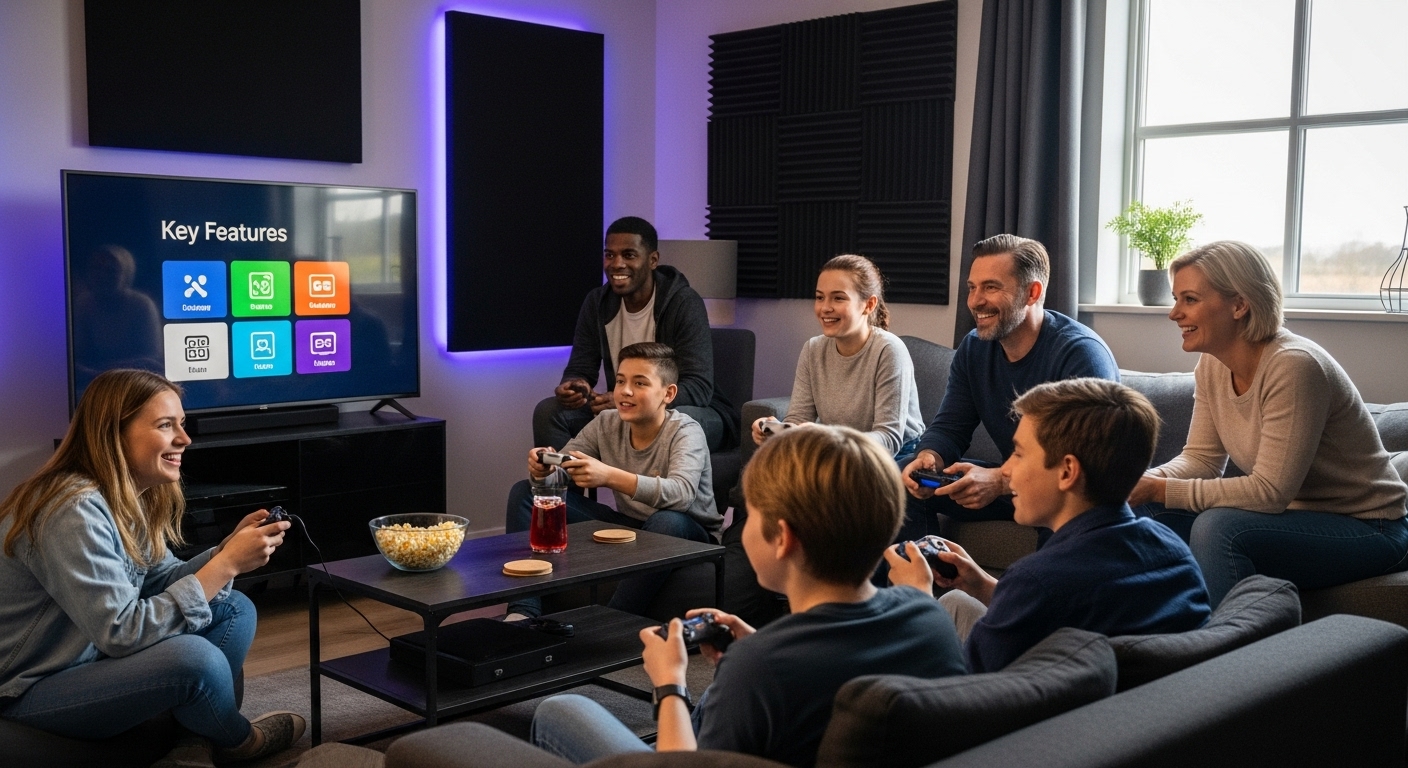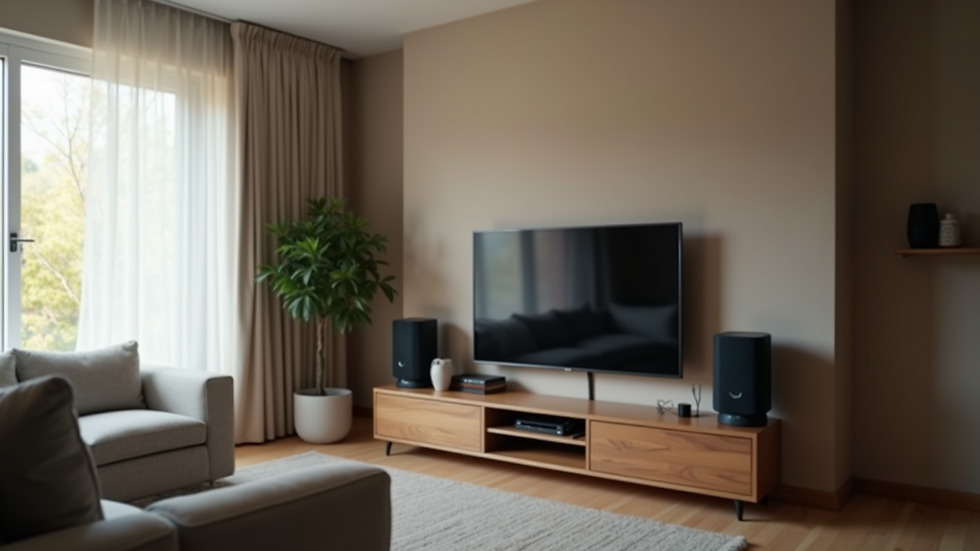What is a Media Room? Understanding Modern Home Entertainment
- garygarihanjr
- Sep 28
- 8 min read

Media rooms are changing how we enjoy entertainment at home. These specialized spaces are built to deliver the kind of immersive experiences that used to be limited to movie theaters or luxury lounges. But it is not the giant screens or high-end speakers that set them apart. The real surprise is how media rooms have become social centers and status symbols, increasing a home’s appeal and even its value. There is a lot more going on behind those blackout curtains than most people expect.
Table of Contents
Quick Summary
Takeaway | Explanation |
Invest in advanced audiovisual technology | High-resolution displays and surround sound systems significantly enhance viewing experiences in media rooms. |
Prioritize flexible design and layout | A well-designed media room incorporates adaptable seating and multipurpose functionality for various activities. |
Integrate smart home technology | Connecting media rooms with smart systems allows for seamless control and a more personalized experience. |
Focus on acoustics for immersive sound | Using acoustic treatments aids in delivering superior sound quality, enhancing overall entertainment experiences. |
Consider the room’s aesthetic integration | Choosing technology that complements the room’s design enhances both functionality and aesthetic appeal. |
Defining a Media Room: The Basics
A media room represents a dedicated space within a home specifically designed for immersive entertainment and multimedia experiences. Unlike traditional living rooms or entertainment areas, media rooms are purposefully constructed to optimize audiovisual engagement, comfort, and technological integration. These specialized spaces transform how families and individuals consume digital content, interact with entertainment systems, and create memorable viewing experiences.
Understanding Media Room Configuration
Media rooms differ fundamentally from home theaters by offering more versatile and flexible functionality. While home theaters aim to replicate cinema environments with fixed seating and strict audio configurations, media rooms embrace adaptability.

These spaces seamlessly blend technology with everyday living, allowing users to enjoy movies, gaming, streaming content, and social gatherings without the rigid constraints of traditional theater setups.
Key characteristics of a well-designed media room include:
Flexible seating arrangements that accommodate multiple viewing styles
Advanced sound and visual technology integrated smoothly into the room’s design
Lighting controls that enhance viewing experiences
Multipurpose functionality beyond pure entertainment consumption
Technology and Design Considerations
Creating an exceptional media room requires thoughtful technology selection and spatial planning. According to Custom Home Design Professionals, successful implementations prioritize immersive experiences through strategic equipment placement and room acoustics. Professional designers recommend selecting audio-visual equipment that complements the room’s architectural characteristics while maintaining aesthetic harmony.
For homeowners considering a media room, understanding the intersection between technology and design becomes crucial. Our comprehensive guide on home theater design tips offers deeper insights into creating stunning multimedia spaces that balance technological sophistication with personal style and comfort.
The Importance of a Media Room in Luxury Homes
Media rooms have evolved from mere entertainment spaces to pivotal elements of high-end residential design, representing a sophisticated blend of technology, comfort, and lifestyle enhancement. These specialized areas serve as multifunctional environments that significantly elevate a home’s aesthetic and functional value, transforming how affluent homeowners experience digital entertainment and social interaction.
Status Symbol and Property Value
In luxury real estate, a well-designed media room functions as more than just an amenity it represents a statement of technological sophistication and refined taste. Potential homebuyers increasingly view these dedicated spaces as critical indicators of a property’s modernity and lifestyle potential. High-end media rooms can substantially increase a home’s market appeal and potential resale value, making them strategic investments for discerning homeowners.
Key attributes that contribute to a media room’s value proposition include:
Cutting-edge audiovisual technology integration
Customized acoustic design
Seamless smart home automation compatibility
Flexible entertainment configuration
Lifestyle and Social Dynamics
Beyond technological impressiveness, media rooms address contemporary social and entertainment paradigms. According to Architectural Digest’s Luxury Living Trends, these spaces provide unique environments for family bonding, social gatherings, and personalized entertainment experiences. They represent a convergence of personal comfort and professional-grade multimedia capabilities.
For homeowners seeking to understand the strategic value of media room investments, our comprehensive guide on why invest in home theaters offers deeper insights into the long-term benefits of creating these sophisticated entertainment spaces.
Key Features and Technology in Media Rooms
Modern media rooms represent complex technological ecosystems that seamlessly integrate audiovisual equipment, smart home automation, and ergonomic design. These sophisticated spaces go beyond traditional entertainment areas by creating immersive environments that adapt to users’ preferences and technological expectations. The convergence of cutting-edge hardware and intelligent software transforms media rooms into dynamic, responsive multimedia platforms.
Advanced Audio-Visual Systems
At the core of media room technology are sophisticated audio-visual systems designed to deliver exceptional sensory experiences. High-resolution displays, precision sound engineering, and adaptive acoustic technologies work in concert to create unparalleled entertainment environments. Professional-grade equipment like 4K projectors, multi-channel surround sound systems, and advanced sound absorption technologies ensure that every visual and auditory detail is captured with remarkable clarity.
The following table summarizes the core features and technologies that define a modern media room, providing an at-a-glance overview of their roles in creating immersive home entertainment spaces.
Feature / Technology | Description |
Ultra-high-definition Displays | Large 4K/8K screens or projectors for crisp visuals |
Surround Sound Systems | Multi-channel audio delivering immersive sound |
Acoustic Panel Treatments | Enhances audio quality and manages sound reflections |
Smart Home Automation | Controls lighting, climate, and AV systems seamlessly |
Flexible Seating Arrangements | Adaptable furniture layouts for different activities |
Lighting Controls | Dimmable, zone-based lights to optimize viewing experiences |
Multipurpose Functionality | Supports gaming, streaming, parties, and more |

Key technological components typically include:
Ultra-high-definition display technologies
Immersive surround sound configurations
Acoustic panel treatments for optimal sound quality
Advanced signal processing equipment
Smart Home Integration
Smart home technology elevates media rooms from standalone entertainment spaces to intelligent, interconnected environments. According to Consumer Technology Association Research, integrated smart systems enable seamless control of lighting, temperature, audio-visual equipment, and room ambiance through intuitive interfaces. Automation transforms media rooms into responsive environments that anticipate and adapt to user preferences.
For homeowners looking to explore the comprehensive potential of media room technologies, our detailed guide on must-have home theater features provides an in-depth exploration of the latest technological innovations and design strategies that define modern multimedia spaces.
How Media Rooms Enhance Home Entertainment Experiences
Media rooms transcend traditional entertainment spaces by creating immersive, personalized environments that dramatically transform how individuals and families interact with digital content. These sophisticated spaces represent more than technological installations they are carefully designed experiences that adapt to changing entertainment preferences and social dynamics.
Personalized Entertainment Ecosystems
Modern media rooms are engineered to provide unparalleled customization and sensory engagement. By integrating advanced audiovisual technologies with user-centric design, these spaces allow individuals to curate unique entertainment experiences tailored to specific preferences. Whether hosting a blockbuster movie night, streaming live sporting events, or enjoying intimate gaming sessions, media rooms offer unprecedented flexibility and quality.
Key experiential enhancements include:
Immersive audiovisual environments
Seamless content transition across multiple platforms
Personalized acoustic and visual settings
Enhanced social interaction capabilities
Psychological and Social Benefits
Beyond technological capabilities, media rooms significantly impact home social dynamics and personal well-being. According to Journal of Environmental Psychology Research, purposefully designed entertainment spaces can reduce stress, enhance family bonding, and provide therapeutic recreational experiences. These dedicated environments create opportunities for meaningful shared experiences and emotional connection.
For homeowners interested in exploring exceptional entertainment space design, our curated guide showcasing inspiring custom home theater examples offers comprehensive insights into creating transformative multimedia environments that elevate home entertainment to an art form.
The Future of Media Rooms in Smart Homes
Media rooms are rapidly evolving from standalone entertainment spaces into intelligent, interconnected ecosystems that seamlessly integrate with comprehensive smart home technologies. The future of these multimedia environments represents a profound transformation in how we conceptualize digital interaction, personal comfort, and technological integration within residential spaces.
Artificial Intelligence and Predictive Technologies
Emerging media room technologies are increasingly leveraging artificial intelligence to create anticipatory, adaptive environments. Advanced machine learning algorithms will enable media rooms to understand user preferences, automatically adjust audiovisual settings, and curate personalized entertainment experiences. These intelligent systems will analyze viewing habits, time of day, mood indicators, and even physiological responses to design truly responsive multimedia environments.
Critical technological developments include:
Context-aware content recommendation systems
Adaptive lighting and acoustic configurations
Biometric user recognition
Seamless cross-platform content integration
Convergence of Physical and Digital Experiences
According to Gartner Technology Research, the future of media rooms will blur the boundaries between physical and digital experiences. Immersive technologies like augmented reality, virtual reality, and holographic displays will transform these spaces into dynamic, multidimensional environments. Homeowners will transition from passive consumers to active participants in interactive, personalized entertainment landscapes.
For those interested in understanding the broader implications of smart home technologies, our comprehensive guide on smart home upgrade strategies provides deeper insights into the transformative potential of integrated multimedia environments.
Ready to Transform Your Home With a Next-Level Media Room?
Imagine stepping into a space that truly captures the comfort, customization, and entertainment capabilities described in our article. Are you frustrated with lackluster sound, cluttered setups, or technology that just does not work seamlessly? When your goal is a sophisticated media room that blends luxury, smart home automation, and the latest audio-visual innovations, experience matters. You deserve a media room that reflects your unique lifestyle and elevates every moment with friends and family.

Take the next step toward the ultimate media room by trusting Techology Experts with your upgrade. See how we bring custom home theater design tips to life and discover must-have features for a truly immersive space. Contact us today to schedule your personal consultation and turn your home entertainment vision into reality before your next movie night.
Frequently Asked Questions
What is the primary purpose of a media room?
A media room is designed specifically for immersive entertainment and multimedia experiences, optimizing audiovisual engagement and comfort for various activities such as watching movies, gaming, and hosting gatherings.
How does a media room differ from a home theater?
While home theaters aim to replicate the cinema experience with fixed seating and audio configurations, media rooms offer more versatility and flexible functionality, allowing for a mix of entertainment options and social interactions.
The table below compares media rooms and home theaters to clarify their key differences and help homeowners identify which best suits their entertainment needs.
Feature | Media Room | Home Theater |
Primary Purpose | Multipurpose entertainment and social gatherings | Cinema-like movie viewing |
Seating Arrangement | Flexible, adaptable options | Fixed, tiered or single-row seating |
AV Technology Focus | Integrated with lifestyle, often hidden or modular | Optimized for cinema-quality audio and visuals |
Room Design | Blends with everyday living spaces | Dedicated, isolated, darkened space |
Functionality | Movies, gaming, streaming, events, socializing | Primarily for watching movies |
Acoustic Treatments | Often present but less rigid than theaters | Precision acoustic treatments for sound isolation |
Lighting Control | Adjustable for various uses | Total blackout preferred |
What are the essential features to consider when designing a media room?
Key features include flexible seating arrangements, advanced sound and visual technology, lighting controls for an enhanced experience, and the ability to serve multiple entertainment purposes beyond just viewing.
How does technology integration enhance the media room experience?
Advanced audiovisual systems combined with smart home technology create responsive and immersive environments, allowing for seamless control of lighting, sound, and audiovisual equipment, which significantly enhances user experiences.
Recommended

Comments